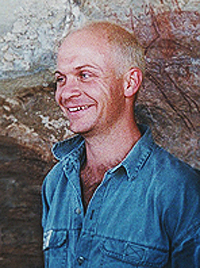 |
 |
APPENDIX 2 - TWYFELFONTEIN SITE REPORT BY SVEN OUZMAN |
16/18 |
Site Description
Twyfelfontein is a vast site complex with many images – perhaps over 5000. It would therefore seem that this favourable living place and spiritual centre was visited and re-visited over many centuries by Bushmen and Khoekhoen. Southern African rock-art dating is notoriously insecure and a great deal more work needs to be done before we are able to date individual images at individual sites; though Twyfelfontein would be an excellent testing ground for such more. Until specific precision is possible, we are able to say certain things in general about Twyfelfontein’s and Southern Africa’s rock-art. For example, Bushman rock-art is Africa’s oldest artistic tradition having started at least 25000 years ago. This date is one that was obtained from southern Namibia at Apollo 11 cave where Dr. Eric Wendt found, in archaeological layers that are between 22000 – 29000 years old, a painted slab of rock on which a part-human, part-feline is depicted. From the Eastern Cape Province of South Africa we know that the last Bushman rock-art was produced about 100 years ago.
Rock engravings have different degrees of weathering called ‘patination’. When a rock engraving is made, the freshly chipped rock has a very light colour, which contrasts sharply with the darker rock around it. As the engraving ages, it acquires what is known as ‘patination’ or ‘desert varnish’ whereby it goes darker in colour. Thus the lighter the engraving, the younger it usually is (unless it is located in a very protected position). Thus at Twyfelfontein some rock engravings may be only a few hundred years old while other, darker ones may be several thousand years old.
The geometric Khoekhoen engravings are just as difficult to date. We known that the Khoekhoen were in this area between 2500 – 400 years ago and so the engravings must date to within this period, though clearly a great deal more work must be done to gain a greater degree of precision on the age of these geometric images.
Meaning of Twyfelfontein’s rock art
The Twyfelfontein Valley occupies a very important place in Southern African rock-art research on account of the vast quantity of rock-art and archaeological artefacts encountered there; as well as the presence of at least two, and perhaps three, rock-art traditions. These rock-art traditions belong to the Bushmen (or ‘San’) gatherer-hunters; the Khoekhoen herders (formerly ‘Hottentot’ or ‘Khoi’) and the enigmatic cupule engravings. Though dominantly a rock engraving locale, Twyfelfontein also has Bushman and a few Khoekhoen rock paintings. The co-occurrence of rock engravings and rock paintings is relatively rare and offers research avenues into the investigation of the meaning of and inter-relationship between these two art forms. Furthermore, the spatially extensive site complex at Twyfelfontein allows an examination of the articulation of rock-art with landscape. Below are a few impressionistic remarks made in regard to the meaning of some of Twyfelfontein’s imagery. The full extent and content of this site complex’s meaning for the people that made it will probably never be known, but even the fragments we can glean today indicate a vast, intricate and full meaning-realm.
Bushman rock engravings and rock paintings
These account for perhaps 80% of the imagery at Twyfelfontein.
Ethnography & Interpretation: Thanks to pioneering participative work undertaken in the 1870s by the German linguist Wilhelm Bleek and his sister-in-law Lucy Lloyd with individuals such as //Kabbo, /Han/kass’o of the /Xam Bushman community. The over 12000 pages of transcribed oral tradition so captured, is today an enduring testament to the now-departed /Xam. Though Bleek and Lloyd soon realised the religious and symbolic importance of Bushman rock-art, this insight was held in abeyance for almost 100 years while non-Bushmen interested in rock-art tended to interpret it in facile, non-Indigenous ways. Ideas such as exotic foreigners like Arabians or Phoenicians were in the 1930s - 1950s thought to have made the bulk of our Bushman rock-art – with the White Lady of the Brandberg being the most (in)famous example. Hunting magic, art-for-art’s sake and aesthetic approaches were all tried and found wanting. It was only when researchers such as Janette Deacon, David Lewis-Williams and Patricia Vinnicombe in the 1970s and 1980s re-discovered the Bleek & Lloyd archive in the Jagger Library at the University of Cape Town that the now commonly-accepted theory that much if not most of Bushman rock-art relates to the shamanistic and symbolic experiences of the Bushmen.
Bushman Ordinary & Spirit World: In essence, the Bushman world-understanding was that there was an Ordinary World in which normal people physically dwelt, and there was a Spirit World in which Gods, powerful Beings, animals and places were located. This Spirit World could only be accessed by people trained to do so. These people were called shamans or Medicine People. Anyone could become a shaman, but their task was a painful and dangerous one as they had to travel in the strange, inversive and often hostile Spirit World and there perform many labours. These labours included making rain, controlling animal’s movements, fighting against evil shamans, Beings and influences and healing people. Non-Bushman understand this Spirit World to be an hallucination induced by an altered state of consciousness. But for the Bushmen, the visual and bodily ‘hallucinations’ represented a very tangible reality.
The Medicine Dance: The Spirit World was accessed by one of the world’s oldest known religious rituals – the Medicine Dance (also known as the trance dance). This ritual involved all members of Bushman society irrespective of age, gender, initiated status and so forth. Though smaller dances also took place, typically everyone would sit together in a tight circle and people would clap and sing, building up a powerful aural soundscape. People would then dance in a circle, stamping, clapping and emphasising repetitive, percussive rhythms and sounds. The singing and dancing would endure for many hours, often at night, until the combination of faith, aural driving, physical exertion and so forth, would cause the dancers – who were and are also shamans – to enter a trance-state – what the Bushman believed to be the Spirit World. The shamans would verbally explain what they had experienced while in trance/Spirit World, and they would also depict their experiences visually in the form of rock-art. Indeed, Bushman rock-art sites may be understood as places where Spirit and Ordinary Worlds connected.
Animals of potency: The dominance of large, powerful animals such as rhino, giraffe, large antelope, elephant and so forth is because the Bushmen believed that their Great God had placed in these animals vast amount of supernatural potency. This supernatural potency was used by the shamans to aid them in the Spirit World endeavours. Sometimes, these shamans believed they had to physically assume the form of their potency animal in order to use its potency.
Interestingly, these insights were applied to Bushman rock paintings even though the /Xam people lived in the Karoo areas of South Africa – an engraving area. Though even now most researchers concentrate on rock paintings, rock engravings are poised to offer us insights into the Bushman mind that rock paintings are unable to. In particular, the association of engraved sites to the wider landscape is a promising avenue of research.
→
A Survey into the Relationship between
Animal-Engravings & Cupules
→
The Rock Art of Twyfelfontein
→
The Rock Art of Namibia
→
The African Rock Art Archive
→
Bradshaw Foundation
Like us on Facebook & Follow us on Twitter to receive news & updates:









